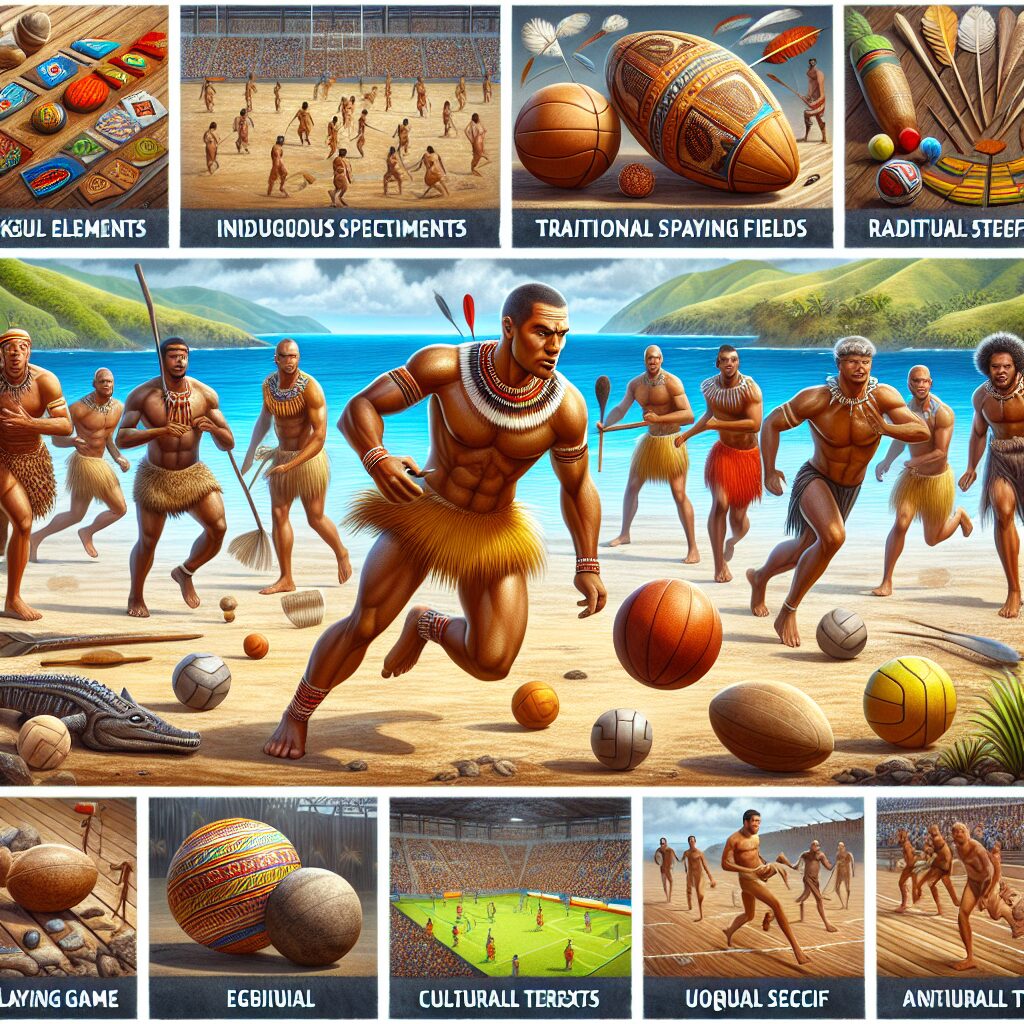Oceania’s Unique Ball Games: Cultural Treasures
In the vast and diverse region of Oceania, a collection of islands scattered across the Pacific Ocean, fascinating and distinctive ball games are embraced as cherished cultural treasures. These games are not merely forms of entertainment, but rather deeply connected to the rich history, traditions, and values of the indigenous people. Understanding the significance and impact of these ball games offers a unique insight into the cultural tapestry of Oceania.
One of the defining features of Oceania’s ball games is their ability to forge strong social bonds among communities. These games are often played in teams, fostering teamwork, cooperation, and a sense of unity. In addition, they serve as a platform for the passing down of traditions from one generation to another, preserving cultural heritage in a dynamic and engaging manner. Moreover, these ball games hold great significance in ceremonial and spiritual practices, with rituals and customs intertwined with the gameplay.
In the upcoming sections, we will delve into the key takeaways of Oceania’s unique ball games. We will explore the various types of games played across the region, highlighting their cultural significance and impact. Furthermore, we will examine the role of these ball games in strengthening community bonds and promoting physical fitness. Through this exploration, we aim to shed light on the extraordinary cultural treasures that Oceania’s ball games represent and the invaluable lessons they impart to both locals and visitors alike.
Key Takeaways
1. Oceania is home to a diverse range of unique ball games that hold great cultural significance for the communities that play them. These games are not only a source of recreation and physical activity, but also a way to preserve and celebrate local traditions and heritage.
2. The Māori people of New Zealand have a distinct ball game called Ki-o-rahi, which focuses on teamwork, strategy, and physical skill. This game involves two teams and a circular field, with the objective of scoring points by touching or catching the ball while navigating through the opposition’s field.
3. The Marngrook game, played by the Aboriginal peoples of Australia, is believed to be one of the oldest forms of football in the world. This game involves kicking and catching a ball made of possum or kangaroo skin, showcasing the players’ agility and coordination.
4. The Sepak Takraw game, popular in Southeast Asian countries including parts of Oceania, combines elements of soccer and volleyball. Players use their feet, chest, and head to keep a rattan ball in the air, displaying incredible acrobatic skills and flexibility.
5. In Polynesia, various traditional ball games are played, such as Kilikiti in Samoa and Ulu Maika in Hawaii. These games often involve hitting a wooden ball with a stick or paddle, showcasing the players’ accuracy and strength while promoting friendly competition and community bonding.
Oceania’s Unique Ball Games: Cultural Treasures
The Origins of Oceania’s Ball Games
Ball games have been an integral part of Oceania’s diverse cultures for centuries. These unique games have deep historical roots and hold significant cultural importance. The origins of Oceania’s ball games can be traced back to ancient rituals and traditions that are still celebrated today.
Different Types of Ball Games in Oceania
Oceania is home to various ball games, each belonging to different cultures within the region. Some notable examples include:
1. Māori Ki-o-rahi
Originating from New Zealand, Māori Ki-o-rahi is a traditional ball game played with a circular field, two teams, and a wooden ball. It combines elements of rugby, touch rugby, and soccer, requiring both physical strength and strategic thinking.
2. Sepak Takraw
Sepak Takraw, commonly played in Southeast Asia, is a game that involves kicking a small rattan ball over a net. It showcases impressive acrobatic skills as players perform aerial maneuvers to keep the ball in play. The game is popular in countries like Thailand, Malaysia, and the Philippines.
3. Kilikiti
Kilikiti is a traditional Samoan ball game similar to cricket. Played with a wooden bat and a ball made from pandanus, it emphasizes teamwork and coordination. Kilikiti is widely embraced in Samoan communities and is often played during festive occasions.
The Significance of Oceania’s Ball Games
Oceania’s ball games hold immense cultural significance within their respective communities. These games serve as mediums for storytelling, passing down cultural traditions, fostering social cohesion, and promoting physical fitness. They help preserve cultural identity and serve as a source of pride for the people of Oceania.
Oceania’s Ball Games Today
While Oceania’s ball games have deep historical roots, they continue to thrive in the modern era. Numerous initiatives are being undertaken to preserve and promote these cultural treasures. Tournaments and festivals are organized, attracting both locals and tourists, providing a platform for communities to come together and celebrate their heritage.
Preserving Oceania’s Cultural Treasures
Preserving Oceania’s ball games requires a concerted effort from both the local communities and external entities. Some measures that can be taken include:
- Creating educational programs to raise awareness about the cultural significance of Oceania’s ball games.
- Providing financial support to organize tournaments and events that promote these games.
- Encouraging the participation of younger generations to ensure the continuity of these traditions.
- Collaborating with museums and cultural institutions to exhibit and document the history and evolution of Oceania’s ball games.
- Engaging in research and documentation to gather valuable insights into the customs and rituals associated with these games.
Conclusion
Oceania’s unique ball games are not only entertaining but also carry deep cultural significance. These games are a testament to the rich heritage and traditions of the region. By preserving and celebrating Oceania’s ball games, we contribute to the cultural tapestry of this vibrant and diverse part of the world.
Frequently Asked Questions
1. What are Oceania’s unique ball games?
Oceania, a region encompassing thousands of islands in the Pacific, is home to a diverse range of unique ball games. These games vary in their rules and purposes but share a common thread of cultural significance.
2. How do these ball games reflect the cultural treasures of Oceania?
Oceania’s ball games reflect the rich cultural heritage of the region as they have been played for generations, often carrying spiritual or ritualistic importance. These games showcase the values, beliefs, and traditions of the diverse communities in Oceania.
3. What role do ball games play in Oceania’s communities?
Ball games hold a significant social role in Oceania’s communities. They bring people together, fostering bonds and strengthening community relationships. These games also provide a platform for storytelling and passing down cultural knowledge from one generation to the next.
4. Are the rules of these ball games similar across Oceania?
No, the rules of ball games in Oceania can vary greatly from one community to another. Each game has its own unique set of rules, often reflecting the cultural practices and beliefs of the specific community that plays it.
5. What materials are used to make the balls for these games?
The materials used to make the balls for these games also differ among different communities. Some games utilize natural materials like woven fibers, leaves, or animal hides, while others incorporate modern materials such as rubber or synthetic materials.
6. Are these ball games only played for recreation?
While many ball games in Oceania are played for recreational purposes, some hold deeper cultural meanings and are played during ceremonial or spiritual events. These games serve as a way to connect with ancestors, honor traditions, and celebrate important milestones.
7. Are these ball games competitive or cooperative in nature?
Both competitive and cooperative elements can be found in Oceania’s ball games. Some games involve teams competing against each other, showcasing athleticism and skill, while others emphasize teamwork and collaboration to achieve a common goal.
8. Are these ball games exclusive to specific age groups or genders?
The inclusivity of Oceania’s ball games varies across different communities. While some games may be traditionally played by specific age groups or genders, there are also games that are open to all community members, regardless of age or gender.
9. Are these ball games in danger of being forgotten?
With the influence of modernization and changing lifestyles, there is a concern that some Oceania ball games might be at risk of fading away. However, efforts are being made to preserve and promote these cultural treasures through cultural festivals, educational initiatives, and community engagement.
10. Can visitors participate in these ball games?
Visitors to Oceania are often welcomed to participate in these ball games as a way to experience the local culture firsthand. It’s an incredible opportunity to immerse oneself in the traditions, learn from the locals, and create lasting memories.
Final Thoughts: Oceania’s Unique Ball Games: Cultural Treasures
Oceania’s unique ball games are not only entertaining but also hold immense cultural value. These games offer a glimpse into the diverse and vibrant cultures of Oceania, showcasing the deep-rooted traditions and values of its communities.
Preserving and celebrating these ball games is crucial to safeguarding the cultural heritage of Oceania. They provide a bridge between the past and present, connecting generations and keeping the spirit of the region alive. As visitors and enthusiasts, let us appreciate and support the continued practice of these cultural treasures, so that they may thrive for generations to come.



